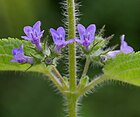Note: This is a project under development. The articles on this wiki are just being initiated and broadly incomplete. You can Help creating new pages.
Hyptis suaveolens
Hyptis suaveolens is a coarse erect annual or often a perennial with stems that become more or less woody and persist. Usually much branched, it is sometimes as much as 2.5 metres high but is generally much lower. The plant has a range of food and medicinal uses, being often harvested from the wild for local use. The plant is occasionally cultivated in Mexico and India.
Contents
[hide]- 1 Uses
- 2 Parts Used
- 3 Chemical Composition
- 4 Common names
- 5 Properties
- 6 Habit
- 7 Identification
- 8 List of Ayurvedic medicine in which the herb is used
- 9 Where to get the saplings
- 10 Mode of Propagation
- 11 How to plant/cultivate
- 12 Commonly seen growing in areas
- 13 Photo Gallery
- 14 References
- 15 External Links
Uses
Rheumatism, Stomach problems, Fevers, Colds, Colds, Dermatitis, Eczema, Boils, Headache, Snake bites.[1]
Parts Used
Young shoots, Seeds, Aromatic leaves.
Chemical Composition
Common names
| Language | Common name |
|---|---|
| Kannada | |
| Hindi | Vilaiti tulsi |
| Malayalam | |
| Tamil | |
| Telugu | Sirna tulasi |
| Marathi | Bhustrena |
| Gujarathi | |
| Punjabi | |
| Kashmiri | |
| Sanskrit | Bhustrena |
| English | American Mint, Bush mint |
Properties
Reference: Dravya - Substance, Rasa - Taste, Guna - Qualities, Veerya - Potency, Vipaka - Post-digesion effect, Karma - Pharmacological activity, Prabhava - Therepeutics.
Dravya
Rasa
Guna
Veerya
Vipaka
Karma
Prabhava
Habit
Identification
Leaf
| Kind | Shape | Feature |
|---|---|---|
| Petiolate | Broadly ovate | Acute at apex, Cordate or round at base |
Flower
| Type | Size | Color and composition | Stamen | More information |
|---|---|---|---|---|
| 8-15cm long | Blue or Bluish purple | Rarely solitary | Flowering season is September-April |
Fruit
| Type | Size | Mass | Appearance | Seeds | More information |
|---|---|---|---|---|---|
| Nutlets | Oblong or Ovoid, flat, Glabrous | Blackish brown | Emerginated at apex with a white mark on either side of the pointed base. Fruiting season is September-April |
Other features
List of Ayurvedic medicine in which the herb is used
Where to get the saplings
Mode of Propagation
How to plant/cultivate
The plant is often an abundant weed, sometimes forming dense thickets of considerable extent that are much visited by birds when the seeds are ripe.[5]
Commonly seen growing in areas
Dry thickets, Waste ground, Open forest areas, Fields.
Photo Gallery
References
- Jump up ↑ Indian Medicinal Plants by C.P.Khare
- Jump up ↑ [Chemistry]
- Jump up ↑ Common names
- Jump up ↑ Kappatagudda - A Repertoire of Medicianal Plants of Gadag by Yashpal Kshirasagar and Sonal Vrishni, Page No. 226
- Jump up ↑ Cultivation
External Links
- Ayurvedic Herbs known to be helpful to treat Rheumatism
- Ayurvedic Herbs known to be helpful to treat Stomach problems
- Ayurvedic Herbs known to be helpful to treat Fevers
- Ayurvedic Herbs known to be helpful to treat Colds
- Ayurvedic Herbs known to be helpful to treat Dermatitis
- Ayurvedic Herbs known to be helpful to treat Eczema
- Ayurvedic Herbs known to be helpful to treat Boils
- Ayurvedic Herbs known to be helpful to treat Headache
- Ayurvedic Herbs known to be helpful to treat Snake bites
- Herbs with Young shoots used in medicine
- Herbs with Seeds used in medicine
- Herbs with Aromatic leaves used in medicine
- Herbs with common name in Hindi
- Herbs with common name in Telugu
- Herbs with common name in Marathi
- Herbs with common name in Sanskrit
- Herbs with common name in English
- Habit - Shrub
- Index of Plants which can be propagated by Seeds
- Herbs that are commonly seen in the region of Dry thickets
- Herbs that are commonly seen in the region of Waste ground
- Herbs that are commonly seen in the region of Open forest areas
- Herbs that are commonly seen in the region of Fields
- Herbs
- Pages without herbs images




